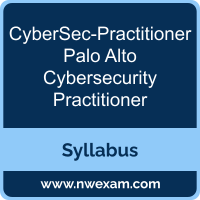 A great way to start the Palo Alto Networks Certified Cybersecurity Practitioner preparation is to begin by properly appreciating the role that syllabus and study guide play in the Palo Alto CyberSec-Practitioner certification exam. This study guide is an instrument to get you on the same page with Palo Alto and understand the nature of the Palo Alto CyberSec-Practitioner exam.
A great way to start the Palo Alto Networks Certified Cybersecurity Practitioner preparation is to begin by properly appreciating the role that syllabus and study guide play in the Palo Alto CyberSec-Practitioner certification exam. This study guide is an instrument to get you on the same page with Palo Alto and understand the nature of the Palo Alto CyberSec-Practitioner exam.
Our team of experts has composed this Palo Alto CyberSec-Practitioner exam preparation guide to provide the overview about Palo Alto Cybersecurity Practitioner exam, study material, sample questions, practice exam and ways to interpret the exam objectives to help you assess your readiness for the Palo Alto CyberSec-Practitioner exam by identifying prerequisite areas of knowledge. We recommend you to refer the simulation questions and practice test listed in this guide to determine what type of questions will be asked and the level of difficulty that could be tested in the Palo Alto CyberSec-Practitioner certification exam.
Palo Alto CyberSec-Practitioner Exam Overview:
|
Exam Name
|
Cybersecurity Practitioner |
| Exam Number | CyberSec-Practitioner |
| Exam Price | $150 USD |
| Duration | 90 minutes |
| Number of Questions | 75 |
| Passing Score | 860/300 to 1000 |
| Exam Registration | PEARSON VUE |
| Sample Questions | Palo Alto CyberSec-Practitioner Sample Questions |
| Practice Exam | Palo Alto Networks Certified Cybersecurity Practitioner Practice Test |
Palo Alto CyberSec-Practitioner Exam Topics:
| Section | Weight | Objectives |
|---|---|---|
| Cybersecurity | 24% |
- Identify the components of the authentication, authorization, and accounting
(AAA) framework
- Differentiate between tactics and techniques as defined by the MITRE
ATT&CK framework
- Identify common threat vectors
- Differentiate between types of phishing attacks
- Describe the characteristics of advanced malware |
| Network Security | 22% |
- Identify common TLS processes and components
- Explain the security function of SSL/TLS decryption
- Identify next-generation firewall (NGFW) placement options
- Explain the limitations of signature-based network protection
- Explain the function of the Prisma SASE components
|
| Endpoint Security | 19% |
- Explain the limitations of signature-based anti-malware software
- Describe Cortex XDR |
| Cloud Security | 19% |
- Describe host-based architecture
- Identify the core tenets of a cloud native security platform (CNSP)
- Describe how Prisma Cloud enables threat detection across Cloud Security Posture Management (CSPM) |
| Security Operations | 16% |
- Differentiate between active traffic monitoring systems and passive traffic monitoring systems
|
Palo Alto CyberSec-Practitioner Exam Description:
The Palo Alto Networks Certified Cybersecurity Practitioner certification is for individuals wanting to validate their understanding of cybersecurity and explore Palo Alto Networks portfolio of solutions and related technologies It is designed for those interested in technical roles in cybersecurity and will validate knowledge and basic application of solutions in the areas of cybersecurity, network security, endpoint security, cloud security, and security operations.
